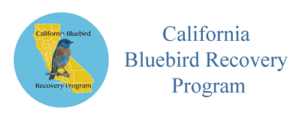Nest Box Trail
Ridge Vineyards, Monte Bello. Photo: Jerry James
Learn about creating a new nest box trail or adopting an existing trail. You’ll also find information about building and placing nest boxes.
Your Nest Box Trail
You can install a nest box, or you can install a “nest box trail”. A nest box trail is simply a series of bluebird boxes in appropriate habitat, often placed so that you can move from one to the next as you check them. Many people ask us about putting a nest box in their backyard which is a great idea if you have the proper habitat. Unfortunately, some people want to get involved but live in an apartment with no backyard. Backyards that don’t have grass or native plants are not necessarily good for nesting native birds.
But of course, down the street is a park, cemetery or other open space that could make a good location for a nest box trail. Some monitors start out with 3-5 nest boxes. There is no need to overdo it.
The following steps are a guide:
This is a commitment
Establishing a nest box trail and monitoring is a commitment. Do you have the time to monitor every week during the nesting season? Also factor in how far the trail is from your home, and how many boxes you want to monitor. You don’t want to burn out. Trails that are too far away can become more of a bother as time goes on. Be sure you are ready to do this for the whole season, to begin with.
We do not want nest box trails to be established and then, not monitored. If you cannot monitor your trail after the first season or at any time, please, find someone else to monitor. Please continue to take care of the boxes until you find a new monitor. Notify CBRP if you are unable to find a replacement. Nest boxes that aren’t monitored can become havens for invasive House Sparrows.
Training
Learn as much as you can about how to monitor nest boxes. Contact your County Coordinator to ask if you can walk a trail with them or another experienced nest box monitor to observe how it’s done.
If your county does not have a County Coordinator, you have the guide and videos we have on our website plus the resources we recommend. Training is available at the beginning of each season. We offer personal coaching to new monitors to help get them established.
Taking over abandoned trails
It is possible there is an abandoned trail you can adopt so you don’t have to start from scratch. Contact your County Coordinator and or local Audubon Society and ask about this. Let’s say an abandoned trail is available, it’s a convenient location for you and you feel you can monitor the boxes already there. Walk the trail, locate each box, and make notes of each box’s condition. If it is during the nesting season, is each box being used? If it is off-season, is there an old nest inside? Is the box in good shape and can withstand another season? Does it leak? Are the seams tight? Is the entry hole the right size or is it chewed on and larger than it should be? Are the predator guards intact? Is the pole secure or is it leaning? How about the immediate area? Is it overgrown?
GPS coordinates can be helpful because you can create a map of box locations. If you don’t have GPS capabilities, draw out a map to remind yourself where they are. You may want to flag the locations of hidden nest boxes with blue flags or flagging tape until you remember where all of them are.
Look for old records of the trail. If not, you will have to start fresh, after you get permission to take on the trail as your own. Then you can make all the necessary repairs or replace boxes. Some land managers have rules like you will need to apply for a permit to enter that area. You may have to notify someone 24-72 hours in advance that you are planning on entering the property or simply email them to let them know. Others will let you go anytime you want.
Other opportunities exist including organizations like Wild Farm Alliance that have nest box trails just waiting for a monitor to take over current trails.
Starting your own trail
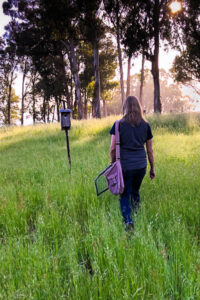 Go to where you want to install nest boxes and walk the area you are interested in putting your trail. Are there open grassy fields and native trees? Are there places that don’t have a lot of human activity? Do you see bluebirds, and/or other secondary-cavity nesting birds like Oak Titmice, Chickadees, or Tree Swallows?
Go to where you want to install nest boxes and walk the area you are interested in putting your trail. Are there open grassy fields and native trees? Are there places that don’t have a lot of human activity? Do you see bluebirds, and/or other secondary-cavity nesting birds like Oak Titmice, Chickadees, or Tree Swallows? - Find out who is managing the land where you want your trail. Whether it is a Regional Park, City or Municipal Utility, you will need to find out who oversees the land and get their contact information and permission.
- Compose an email saying you are interested in installing nest boxes on their land for the benefit of secondary-cavity nesters. Explain what the benefits are for the birds and how the birds benefit us. Explain that you will monitor the boxes and keep them in good shape. You can refer them to the www.cbrp.org website. Mention that you are getting trained by The California Bluebird Recovery Program and have our support. If they would like to contact us, that is fine. We can even write a separate letter to your contact explaining what we do.
- If the response is favorable, you will need to give them a map of nest box locations. You can ask the ranger or representative to walk with you to stake location flags. It may take some time to get approvals but don’t give up. Many land managers are interested in supporting local conservation and will gladly help you. There is an approval process. Don’t give up if they tell you they don’t want nest boxes. Find another location with a different land manager.
- If your trail will need poles and digging is involved, you may be asked to call 811 and go through that process to determine if there are live gas lines underground. This is an important reminder and don’t hesitate. It is an easy thing to do compared to breaking a gas line.
- Be mindful of regular activity that happens near where you are putting your nest boxes. For example, picnic areas are often quite active with children looking for mischief. They get curious about nest boxes and that added attention can be trouble for a mama bird. The kids might knock on the box and disturb the nestlings or hang around the box and prevent regular feedings. Don’t place your nest box in areas known to be active and take into account the kinds of people you can expect to happen by.
- Mowing is another activity that often happens. Nest boxes should be placed so as not to interfere with mowing or other regular activities. Likewise, place them so that the nest box itself is not disturbed by mowing or other regular activities.
- Construction and nest boxes don’t mix. Before placing a nest box, be sure that construction is not scheduled at all during the nesting season. If your nest box has an active nest when construction is set to begin, by law, that construction MUST be delayed. It is therefore very important that you don’t inadvertently cause that delay. Consideration on your part will be appreciated by management. All birds have a radius around which construction can’t occur, while the nest is active. Each species has a different distance from which construction is prohibited. The actual distance isn’t as important to you. You should take no chances if you hear that construction may happen. It is better to wait and have the full support of management and staff than to cause interference and delay.
- Government agencies, corporations and property management may have liability concerns. Don’t let this discourage you. Waivers of liability may need to be signed. This is no different than many activities anywhere else. Another possibility is that property management may ask if you have a certificate of insurance. Don’t assume this will be requested but if it is, don’t panic. Some Audubon Society chapters have insurance for volunteers, and they may be willing to add you to their insurance certificate. It doesn’t hurt to ask. Another option is to investigate volunteering for the agency or organization. For example, a county park system, municipality, or Public Utility may have their own volunteer group that you can join with the intention of making nest box monitoring your volunteer job for them. This is exactly how some of our volunteers get around insurance requirements.
- Once you get permission to install your nest boxes, you will have to plan out the installation day. Celebrate your success and please, contact us with your trail name and location. We will look forward to receiving your data at the end of the nesting season. And remember, if at any time you have questions, need support and advice, we are here for you.
Why do Bluebirds Nest in Boxes
There are three species of bluebirds indigenous to North America. Western Bluebirds (Sialis Mexicana), Mountain Bluebirds (Sialis currucoides) and Eastern Bluebirds (Sialis sialis) are cousins in the Thrush family. Considered iconic as a symbol of Happiness, included in folklore, art and music, native Americans believed bluebirds embodied renewal and sunrise. Lucky for us California is part of the Western and Mountain Bluebird’s range where they live year-round!
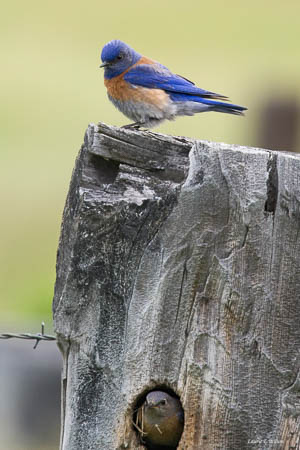
Bluebirds are classified as “secondary-cavity nesting birds” because they do not possess the physical capabilities to make their own cavities. They, like other secondary-cavity nesters, nest in cavities caused by decay in dead or dying trees, cavities made by “primary-cavity nesting birds”, or artificial cavities (nest boxes) constructed by humans.
Primary cavity-nesting birds, such as woodpeckers, have the physical ability to drill out chambers in trees. Primary cavity nesting birds typically only use a nest site once. Once abandoned the nest hole becomes available for other species to use. Competition for natural cavities can be fierce.
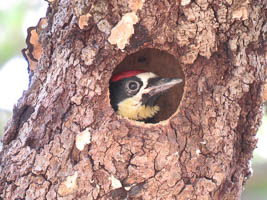
Due to loss of habitat due to agricultural and urban sprawl plus excessive use of pesticides bluebird populations plummeted by the 1970’s. People often remove dead or dying trees, and this has contributed to the loss of natural cavities for cavity nesting birds. The introduction of competitive, invasive, and often vicious bird species such as House Sparrows and European Starlings has also impacted bluebirds. Nest box programs effectively support the conservation of bluebirds thus, increasing their survival and population growth.
Habitat and Where to Place Your Nest Boxes
Bluebirds need food, water, cover, and places to raise young. They need “habitat”. The first factor birds need in selecting a place to live is a source of food. Food is just one component of habitat, but it is critically important. Once food is accounted for, it is time to find a place to raise young. Birds are driven to reproduce so they may not be as picky as you might expect.
The place a nest box should be placed is somewhere that has all the insects a bluebird can eat, all the water it can drink but has a shortage of places to raise their young. You are looking for a habitat that is almost complete. And of course, that means that a nest box is only going to help these birds if everything else is there.
If you have no bluebird food source, you will have no bluebirds, whether you have a nest box or not. If you wonder why bluebirds don’t move into your nest box, now you know. It could be that they don’t have what they need to live in your area. Alternately, with no nesting opportunities nearby, it may take a while for bluebirds from another area to spread into your neighborhood. It could be just a matter of time. One thing is for sure: You won’t have bluebirds in your nest box if there are no bluebirds in your neighborhood.
Bluebirds had not been seen at Asilomar in Monterey County for 90 years, until nest boxes were installed. Placing nest boxes in what appeared to be “bluebird territory” allowed a pair of bluebirds looking for a home to spread into new habitat. If you already see bluebirds in your area, you know there’s a chance they’ll use a nest box installed for them. If you don’t, perhaps you have the wrong habitat or perhaps they have simply never been given a chance to nest in your neighborhood.
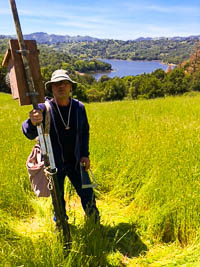
The old-time version of bluebird habitat was open woodland with cropped grassland that would allow for good hunting. That still describes a good habitat for bluebirds. Look for grassland, generally at least an acre’s worth. Bluebirds have been found away from grassland but not away from ground-dwelling insects. That is the key.
Oak woodland makes good bluebird habitat. Although they prefer oaks in semi-open grassland habitat, bluebirds will be the judge of what they want in livable habitat. Native trees are hosts for butterflies and moths (and thus, caterpillars). Oak trees are “keystone species” in the words of Doug Tallamy, as are many other native trees.
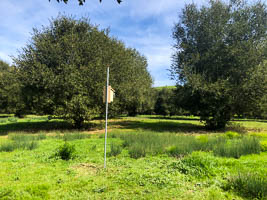
A mix of oaks and conifers will attract other species such as Oak Titmice, White-breasted Nuthatches, Chickadees among others. Bluebird nest boxes suit other nesting birds as well, if they’re placed in appropriate habitat. You could be providing nesting opportunities for other species that need cavities! Monitoring nests of Ash throated Flycatchers, Violet Green Swallows, and other cavity nesting birds is just as valuable to their success as it is the bluebirds! As we said, each species has a different diet and has different needs.
Riparian habitat is the term for territory along creeks and rivers. Willows often dominate riparian habitat. Tree Swallows tend to prefer grasslands close to bodies of water like reservoirs, lakes, and streams. They can be found wherever there are flying insects, but they prefer to nest where their food source is plentiful.
The birds know what they need in safe housing. We will tell you where to put a nest box but there are times when the birds choose a house that goes against our advice. Does it matter if you put up a nest box in the wrong place or without the things we recommend? Yes, I’m afraid it makes a difference to the chances the birds will be successful in raising their young to fledge. Success may start with a bird laying eggs but they aren’t successful until the young have fledged. We will tell you what it takes to put up the safest nest box for the best chances of success.
Who would think that a nest box on the side of a house, under an eave, next to a kitchen window, in an urban Bay Area town (El Cerrito) would be used for a bluebird nest? There was ample grassy areas in that El Cerrito neighborhood plus a small but productive orchard two houses down. There are native oaks. The birds used the neighbor’s bird bath daily! Great habitat!
That next box has been home to six successful broods in three years. Just because this nest box is near a house doesn’t make it an unsafe place for nesting. In fact, it might be very good, if predators don’t like to hang out near homes. But there are bad places to put nest boxes, too. There are badly made and designed nest boxes. We need to take the safety of our tenants into account.
Unfortunately, not all yards are as accommodating. Neighborhood cats, frequent human activity such as busy sidewalks, windows open and showing constant movement from human inhabitants and such can lead to real problems for anxious bluebird parents.
There are some nest boxes that have bluebirds landing on them moments after they’re put up. Others don’t get bluebirds at all, even when the habitat appears perfect. The birds can find your box immediately or it can take several years. Don’t get discouraged. If your nest box is not used by native birds after two or three years, you might consider moving it to another location.
What a bluebird would have had years ago is a nice grassy woodland with low vegetation that was perfect for ground-dwelling insect-life. Before civilization came along, old trees provided good nesting opportunities. Nowadays, dead and dying trees are considered hazards and are removed. They are no longer available for nesting and a critical component of bluebird habitat is gone. Nest boxes allow us to provide a place to nest, a replacement for what we have been taking away. Nest boxes can mean that bluebird habitat is back!
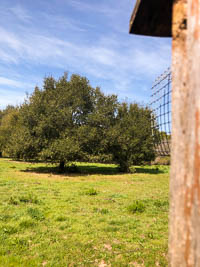
Trees and bushes are good for bluebirds. Think like a baby bird. Pretend you are looking outside the entry hole into the world for the first time. What do you see? Is there a tree or shrub where you can fly for cover? Fledges are extremely vulnerable to predation and the predators have surely been watching the nest box.
A tree or bush for fledglings to fly to not far from your nest box can increase the chances that our young fledglings’ first flight isn’t also their last flight.
Birds also need places to perch. Fence lines, telephone lines and medium trees can be used to guard their nests and hunt. Just be sure they can’t be used to help predators access the nest.
Do you see significant grassland?
Western and Mountain Bluebirds generally like Oak-studded grasslands where they can glean caterpillars and other insects from the grasslands and oaks. This can be in open space areas where there are few people, vineyards, farmlands or in more urban areas like parks, golf courses, cemeteries, large lawns, mowed meadows, and easements. Some neighborhoods have nearby schools, small orchards and gardens that create an oasis.
Are you confident the location you select isn’t going to be heavily trafficked by people?
While bluebirds can tolerate seeing people regularly, too much activity can discourage the adults from feeding their young on a regular basis. We have many nest box trails in golf courses and parks where people are considerate of nesting birds. Just be aware it can become a problem if there are too many people walking back and forth close to your box while they are nesting.
Do you see House Sparrows or Starlings nearby?
If you see House Sparrows, you may end up battling with them over who gets to nest in your box. House Sparrows will kill baby birds in the nest, poke holes in eggs and even kill adult birds.
Starlings are easier to deter if you make sure the nest box entry hole is the right size. They cannot enter a box with a 1 1/2” entry hole. This is good news for bluebirds.
Do you know if they spray herbicides and pesticides?
When you ask permission to set-up a nest box trail, do some research. Be sure to contact the land manager and ask about their use of insecticides and herbicides.
Are cattle grazing?
This is quite common and in general doesn’t deter the birds from using nest boxes. Now and then, cattle will use a pole to scratch themselves but for the most part cattle grazing does not pose a threat.
What about feral or outside cats?
We do not recommend installing a nest box if you have cats. They are persistent and will be a relentless problem. We discourage putting nest boxes near them.
Hints for Box Placement for Different Species
Western Bluebirds:
Distance your nest boxes about 100 yards apart. Keep the box raised at least 5’ off the ground. Western Bluebirds need hunting territory of about 2 to 5 acres. Turn the box away from prevailing winds and rain. Some trails have both bluebirds and cavity nesting swallows. You may see them battling for the same box. If this happens, install another one (called “pairing) 5- 20’ away. If you pair them, don’t have the boxes facing each other. In general, it is not unusual to find a Tree Swallow nesting close to a bluebird this way.
Mountain Bluebirds:
Distance their boxes 200-300 yards apart. Their territory may be about 12 acres but decreases during the nesting season (Pearman). Mountain Bluebirds are known to need more territory than Western Bluebirds.
Bluebirds have been known to nest closer together if the foraging is plentiful. These are general guidelines.
Oak Titmice and Chickadees:
We encourage monitors establishing new trails to choose locations for Oak Titmice and Chickadees. Oak Titmice are in decline. In general, both species like mixed woodlands but will also nest in boxes on private property where there are feeders available. The main difference for them is the size of the entry hole. They use a 1 1/8” size entry hole.
It is not a good idea to place their box within sight of the feeders’ station because their nest will attract predators like curious Jays.
Features of a Good Nest Box
What makes a safe, effective nest box? Which plans are the best to use? And why should I choose one design over another?
Keep in mind that there are regional variations in bird species, predators, climate, and other factors. Nest box styles or features that work well in one area may not work as well in others. Many monitors have developed their own sense of what works. We recommend that you contact a County Coordinator in your area to learn what nest box is best for your area. If your county does not have a coordinator, we do have recommended plans here. And we will be happy to answer any questions. You can submit them to our Facebook page or email them to info@cbrp.org.
Commercial nest boxes are available from specialty bird-feeding stores, online and sometimes, well-meaning people build their own from plans they create themselves. Even hardware stores sometimes carry nest boxes.
Unfortunately, many nest boxes available commercially, especially in stores that cater to the general public (in other words, hardware stores), are of poor quality and are unsafe for nesting birds. This isn’t universally true, but buyer beware! We hope to make you aware of what to look for so you can examine potential nest boxes and determine which are good and which to avoid.
Nest box plans are easy to come by. California Bluebird Recovery Program has endorsed particular nest box plans that we feel serve California native cavity nesting birds best. Wherever you get your nest box or plans, you should be informed on the criteria of a good nest box.
There’s no such thing as a fail-proof nest box. For one thing, what goes on outside the box can have implications for what happens inside. By following certain guidelines, you will increase the odds your birds will be safe during the nesting season and that the offspring will fledge successfully!
Success is an important word here. These birds are driven to reproduce. They will choose the worst nesting opportunity if that is all that is available. Eggs being laid in your nest box is not necessarily an endorsement of a good, safe nest box. It could be an indication that your offering is all that the birds could find. Some nest boxes have a dismal success rate. For the record, the nest is not successful until the birds fledge.
Nest boxes intended for bluebirds often attract other birds! Other secondary-cavity nesting birds that readily use songbird nest boxes are Tree Swallows, Violet-green Swallows, Chestnut-backed Chickadees, Oak Titmice, Ash-throated Flycatchers, House Wrens, White-breasted Nuthatches and Red-breasted Nuthatches. Some of these birds are smaller and can use slightly smaller boxes. For now, we’ll discuss bluebirds but we will come back to those other wonderful birds that are every bit worthy of our help.
So, let’s get started:
First, consider construction materials to help the box last, maintain safe temperatures and keep it safe from predators.
MATERIALS:
- Use solid wood ¾ to 1 inch thick. If you use a softwood such as pine, stain the outside or use a water-based paint (again, the outside only) to preserve the wood. Hardwoods weather the best but they are very expensive. Some people use redwood boards taken from old fences that have been taken down. Redwood is readily available in California. Cedar is a commonly used wood in the east, but it is not easy to find in this state.
- DO NOT use pressure-treated plywood because it can be toxic. Cardboard deteriorates quickly. Metal will heat up in hot weather or clay and ceramic since they break and retain heat. Plastic is used in various forms at times but be careful that hot summer temperatures don’t overheat them.
- Plywood is used by some of our long-time nest box caretakers. They are careful to sand their boxes well. Some will criticize the use of plywood fearing chemicals. Well-sanded plywood should not be a problem but do be careful not to allow a chemical smell buildup inside your box. It could be deadly. We have seen plywood boxes used successfully for years now. Just be careful. And you may notice that the wood used on those boxes is recommended to be much thinner, ½ inch walls, than our recommendations above. Keep in mind that this is only appropriate when the nest box will be hung in a tree as a hanging box. The protective canopy of the tree can keep internal nest box temperatures much more pleasant than those in the hot sun.
ACCESS (Openable):
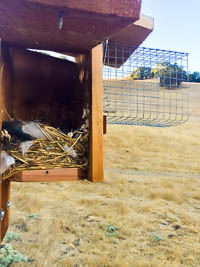
- Nest boxes need to be opened – whether it’s a side door like this one that pivots up, or one that opens downward, front opener, roof opener … each has its pros and cons and is a matter of personal experience. Those that open from the side have a number of advantages and is preferred by many. Front opening boxes do work well but predator guards can’t be used on them. DO NOT use a box that opens from the bottom.
- Secure the door. Some nest boxes use a squared bent hook to keep the door closed. Some nest boxes use a nail inserted into a hole drilled at a downward angle through the side of the box into the door. A double-headed nail is easy to grip because it protrudes. Both are good if you are positive there will be no human mischief. Nest boxes mounted in public parks often use a Phillips-head screw to secure the box since park visitors wouldn’t be expected to carry a screw driver.
ROOF:
- The roof should cover the back edge of the box and extend over the entrance hole in the front as well as beyond ventilation holes. An overhang especially in the front is recommended.
- We recommend using wood for your roof.
- DO NOT use plexiglass or a galvanized metal roof. These could cause overheating.
- Keep the roof intact. Holes in the roof, even if they have screws through them, can cause leakage during rainstorms. Do your best to keep the roof intact and solid.
- The roof is used to keep rain, snow, sun and predators out of the box. It’s also to prevent temperature extremes. Make sure the roof is firmly attached to the box. Racoons have been known to rip roofs right off the nest box.
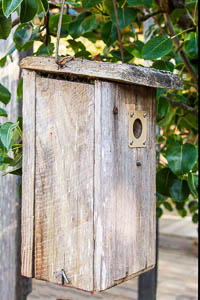
ENTRY HOLE:
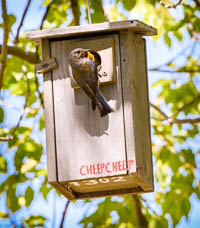
- Entrance hole size is very important. Secondary-cavity nesters other than bluebirds need entry hole sizes larger or smaller; for instance: Chestnut-backed Chickadees need a 1 ¼” entry hole. Barn owls need 4 ½” x 3 ¾”! The dimensions of an appropriate chickadee box or barn owl box are different. As a rule, you should have an entrance hole no larger than the target bird needs. A larger hole lets in larger birds like starlings. This often spells doom for hatchlings.
- The Western Bluebird needs a 1 ½” diameter round entrance hole and the Mountain Bluebird needs a 1 9/16” diameter entrance hole. Where species overlap, use the larger opening. The recommended depth from the bottom of the entry hole to the floor is about 6”.
DIMENSIONS:
- Nest box dimensions are important to consider. You want a nest box tall enough so that there is distance between the entrance hole and the top of the nest where the young birds could be picked up by predators. Plans are available on our site. You can find the dimensions we recommend with those plans.
- Dimensions should provide enough floor space to allow a larger clutch of nestlings to wave their wings and practice flying. If the nest box is too large, the larger profile of the box can catch wind or be easy for a predator to spot.

KERFS:
- Create kerf cuts below the entry hole so fledglings can exit the box by having something to grip on. Kerfs are like a ladder to the young birds. Keep in mind that natural cavities have rough sides whereas the walls of a nest box are smooth and provide no footholds. This can be as simple as scratching the wall with a nail.
- Hardware cloth should not be used as a substitute for kerfs as the young bird’s feet can get caught in it.
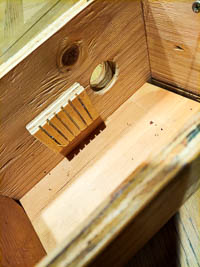
WATER RESISTANCE AND DRAINAGE:
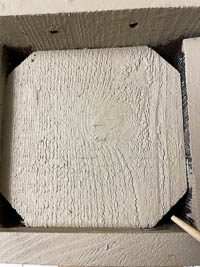
- Take steps to see to it your box isn’t susceptible to rain and wetness. This usually means that ventilation should be such that it doesn’t let the rain into the box. That can be tricky. It is important that you find a way to keep the inside of the box dry while you facilitate air circulation.
- Inevitably, water will enter the box and when it does, it must have a way to leave. While some people drill holes in the bottom of the box, a far better way to provide drainage is to cut the corners of the floor to provide triangular holes. These might seem too large at first, but they are covered quickly by nest material and continue to provide drainage when drilled holes would clog up.
- Exterior seams should meet and be tight.
PAINT/STAIN:
- Painting the exterior can lower the heat inside a box and preserve the wood. See Lee Pauser’s experiment using light colored paint for reducing the nest box internal temperature.
- Leaving natural wood has worked well since nest boxes were invented. This is especially true with cedar or redwood, but if you want to paint your nest box, use light more natural colors to reflect light. Remember that if the parent birds can be seen entering the box, trouble could follow. These birds evolved to camouflage against naturally colored backgrounds. When you paint the box, please keep this in mind.
- DO NOT paint the inside of the box.
VENTILATION:
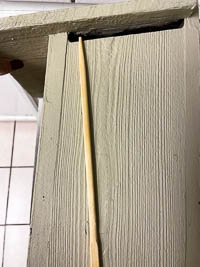
- Vents and/or vent holes should be part of the box. If you drill vent holes, angle them upward to reduce the chance of water getting in.
- Vent holes can be plugged in the winter or wet weather during extreme weather events.
- A double roof can be utilized, made with two pieces of wood with an air space between to keep the interior from getting too hot.
NO PERCH:
California’s native birds do not need perches. Worse yet, they only serve to provide help to competitors and predators. Please leave your nest box without a perch.
PREDATOR GUARDS:
A good nest box uses measures to deter predation. Though predator guards will be discussed later, they are part of a good nest box.
We have covered basic features of a sound nest box for bluebirds and other smaller secondary-cavity nesters. The California Bluebird Recovery Program also promotes the conservation of Barn Owls, American Kestrels, Northern Flickers, Screech Owls, Wood Ducks and many more. Each one of them requires a different nest box which we will discuss and cover in future videos.
Mounting your Nest Box
There are several ways to mount a nest box. We covered hanging nest boxes separately.
Pole-mounted nest box
Let’s start with the best. Hands down, mounting nest boxes on poles is the best method from a bird-safety standpoint. While hanging nest boxes are generally successful all-around California, pole-mounted nest boxes are the most successful, as a group, everywhere.
With the right tools, installation of pole-mounted boxes is easy and can be done flexibly wherever you want. While hanging a nest box in a tree requires the tree, pole mounted boxes can go wherever there is open ground. Pole-mounted nest boxes can support a stove-pipe baffle, a snake defeating predator guard that cannot be used on other mounting types. This makes the pole-mounted box the best choice in snake country. The Noel guard can also be added making for the most predator resistant nest box available. Snakes can climb poles, as can certain other predators. Avian predators like jays can also be a problem for an unprotected pole-mounted nest box so serious consideration should be given to using either or both of these added safety items.
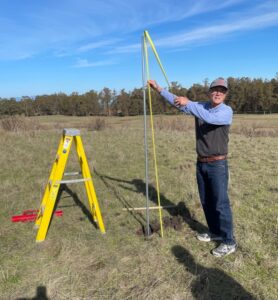
You can use conduit or metal piping to mount your nest box. If you use conduit, you can create a telescoping pole that allows your box to be lifted and dropped so it sits higher but is easily checked.
Sinking your pipe into the ground is achieved most easily using a “fence post driver”. This is a cylinder with handles that can drive the post into the ground. A post hole digger can start the process if ground is particularly hard. Shovels and digging bars might also help, but the driver is often all that is needed. If hard ground is a real problem, try doing it after a rain when ground is softest. We don’t recommend using concrete but that is up to you. Remember that you can use a rock, or something buried in the ground next to the pole to help stabilize it, sometimes referred to as a “dead man”. Some people drive a 4′ piece of rebar 2′ into the ground and slip the conduit over the exposed rebar. The conduit can then be driven partially into the ground.
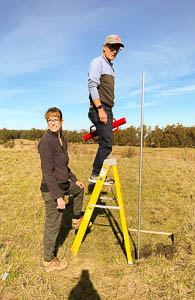
If you decide to use the telescoping pole idea, get two diameters of electrical conduit in which one size fits relatively snuggly inside the other. Drive the larger diameter into in the ground and drop the smaller diameter piece a few inches down into the first pipe. Drill a hole using a power-drill with a drill-bit specifically made for metal and insert a screw to hold the upper pipe in place. You will need to remove this screw every time you monitor. This will allow you to lower the nest box to a convenient height to look in. You can raise it back up when you are done.
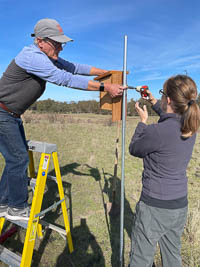
Now that your pipe is in place, you can attach the nest box. You can do this using a pair of conduit clamps or U-bolts. You may want to drill a hole in the back of the conduit clamp to allow for a screw that can prevent the clamp, and therefore, the nest box, from sliding up and down the pole. The conduit clamp or U-bolt will need to be the size of the pipe. A pipe cap can be placed on top of the pipe to prevent rainwater from entering the pipe and causing deterioration.
Fence or Post-mounted Nest Box
There are times when a post mounted or tree mounted nest box are appropriate, but it should be known that both are quite inferior to pole-mounted nest boxes. They are not nearly as safe as a fully fortified pole mounted box. If you have the option of using pole mounted nest boxes, we really want to encourage their use instead.
When would you use a post-mounted nest box? There will be cases where installing a pole in the ground can’t be done or require a lot more effort. For example, in some places, installing a pole for a nest box is considered “development” and must go through the same approval process as erecting an actual building. This approval-overkill can prevent pole-mounted nest boxes from being installed.
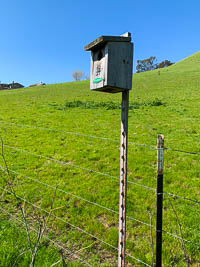
Placing a nest box on a fence or post may be as simple as using a battery powered drill to drive the screws through the box and into the post. Post-mounted nest boxes are easy to place and easy to take down and move. They’re rustic and attractive. But they’re easy for a snake or raccoon to climb and raid. They are considered unsafe by many nest box monitors. Keep good track of weekly monitoring records. If predation is too rampant, you can use it to justify a safer alternative.
Tree-mounted Nest Box
Not to be confused with a hanging nest box, a box mounted to the trunk of a tree is considered even less safe than a post mounted nest box. Some nest box monitors shudder to think of it. They are, once again, very easy to install and to uninstall, using a battery-operated power drill just as with post installation.
Golf courses are one example of a location we frequently mount nest boxes on trees. Adding poles to a golf course can be problematic but there are plenty of trees and bluebirds are a favorite sight of golfers out on the greens. Once again, keep track of predation through weekly checks. Watch for House Sparrow infestations and missing eggs or nestlings.
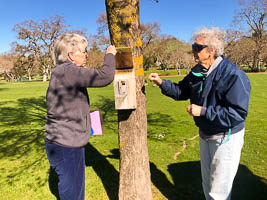
Hanging Nest Boxes
There are several ways to install nest boxes. One method is to hang nest boxes in trees. Hanging boxes are appropriate all over California.
A hanging nest box is like other nest boxes, but it has a wire hook coming out the top. Balance is important when making a hanging nest box.
Hanging boxes require a “nest box retriever” or “nest box lifter” to install and remove from a tree. Different kinds of nest box retrievers can be made. Nest box monitor Dick Purvis developed the hanging nest box system decades ago.
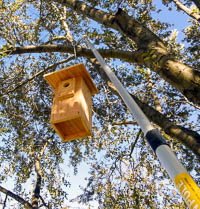
The common component of a nest box lifter is the pole. Most lifters use a painter’s pole or swimming pool net pole.
One simple kind of nest box retriever is a hook attached to the end of the pole. Having the weight of the box hanging below the pole can be awkward and it is usually best to keep boxes lower in the tree when using a retriever hook.
Another version of the nest box retriever uses a basket or cage. The original baskets were made of wood and were quite heavy. More recently, those baskets have been made with wire or cloth.
Plans for both styles of retrievers are here.
Hanging nest boxes have their advantages and disadvantages. On the “pro” side is that in California, hanging boxes are not as prone to ground-dwelling predators as other kinds of nest boxes. Specifically, those mounted on the trunks of trees or on posts are particularly susceptible to snakes, lizards, and certain other predators. Where vandalism is a concern, hanging nest boxes are more discrete and hidden. Even when they are discovered, it takes more effort to disturb them. Sites near picnic areas are often bad places for nest boxes because of kids with “idle hands” but hanging nest boxes is often the answer.
It needs to be pointed out that California does not have the kind of tree-climbing snakes that some other states have. Nest box monitors in Louisiana are flabbergasted at the thought of hanging nest boxes in trees. Their tree-climbing snakes make hanging boxes unthinkable. But California doesn’t have such a problem with snakes in trees, usually. Gopher snakes compromise our biggest fear, snake-wise, and they even make it into our trees now and then. But no form of nest box is completely risk-free. Every region is different and even within California, what succeeds in one part of the state may not work elsewhere. Monitor your nest boxes and do what works.
Hanging nest boxes have advantages but they have their drawbacks, too. It takes a certain amount of upper-body strength to lift the nest box off branches. This is especially true if your nest box was placed higher up in a tree. Don’t over-extend. Do what is comfortable and be sure that you can use the nest box lifter safely. It is better to have the nest box lower in the tree than to overdo it and drop the nest box on the ground with a nest full of chicks.
Lee Pauser monitors hundreds of hanging nest boxes. He has made a video demonstrating how to retrieve and re-hang them and here are written instructions he wrote:
If you have a multi-section extension pole, one technique to lower the boxes is:
- Look at the hanging nest box noting where it is hung, because you will want to rehang it in the same location.
- Turn the retriever’s hook slightly in the direction of the box side of the box’s hanger. See the below photo noting the hook is turned slightly to the left. This will allow the retriever’s hook to slip between the box’s hanger more easily, and the tree’s branch.
- Stand under the box, extend the extension pole locking each section so it is long enough to reach the box’s hanger, and lift the box off the branch using the retriever’s hook.
- While keeping the pole vertical, lower the box until the end of the pole can be placed on the ground. (With the pole vertical and one end the ground, the pole bears the weight of the box.)
- While holding the nearest section of the pole, unlock the section, and slowly lower the box until that section of the pole is completely lowered or the box is within reach, then lock it. (Note that one end of the pole is still on the ground bearing the weight.)
- If the pole has another section, repeat #5 above if needed.
To re-hang the box, do steps 3-6 above in reverse order–unlock, extend, and lock each section while keeping the pole vertical and on the ground. Once the retriever’s pole is extended far enough, lift the pole with box off the ground, and re-hang the box.
Predator Guards
Bluebird landlords. That is a term used by “bluebirders” across the country. Bluebird monitors take the safety of their nestlings seriously. Cavity nesting birds live in the wild kingdom and their lives are filled with drama. Bluebird nestlings are actively hunted around the clock. We can’t get mad when they fall victim to a snake or racoon. Snakes and racoons deserve our respect every bit as much as birds, but we aren’t setting up snake feeders. We are landlords and a safe living environment is every bit as much our responsibility as it is for those people who own the houses we humans live in.
We want to discuss some devices that offer just a bit more protection to our “tenants”.
Wood Guard
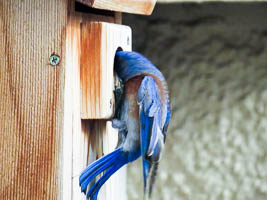
Our first device is called a “wood guard”. This is simply a piece of added wood on the front of the entrance hole. It forms something of a tunnel.
Our bluebirds have no problem navigating this tunnel but certain predators, particularly starlings or other larger birds, must stick their head through a longer tunnel to reach the young with their beaks. An inch can save a life. The wood must obviously have the same sized entrance hole drilled into it as is the original entrance hole diameter.
Another common problem is woodpeckers who can set about to open the hole up. By widening the hole, they allow larger birds in or use the box to store acorns, and these are problems. The wood guard can be used to close the hole back down to the proper diameter. It can be replaced every year if need be.
And it should be noted that not every nest box can support a wood guard, or other guards over the front of the nest box. This is because if the nest box opens from the front, the guard will hit the roof. This makes the nest box effectively unable to open. For these guards to work, the nest box door should be along the side.
Noel Guard
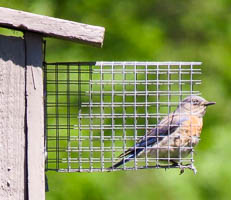
Another frontal protector is something called the “Noel Guard.” It is made of hardware cloth wire and creates a wire tunnel. It works surprisingly well. Those predators that can figure out how to stick their paw or beak through it still don’t have the reach to quite make it inside. And others just can’t quite figure out why they can see the hole but not get in. Noel Guards are easy to make.
Stovepipe Baffle
The best part of a stovepipe baffle is that it can be used in conjunction with a Noel Guard to set up a real puzzle for most predators. Stovepipe baffles can only be set up on pole-mounted nest boxes.
The stovepipe baffle uses an 8-inch stovepipe, an 8 inch stovepipe cap with a hole the same size as your pole, and a screw or other method of holding the cap up onto the pole. The stovepipe should be free floating to discourage racoon climbers.
Snakes and other unwelcome visitors may try to ascend the pole in hopes of looking in the nest box. The way this works is that they will enter the stovepipe and hit a dead-end. The largest snakes can defeat the stovepipe baffle but then they must defeat the Noel Guard. It is the “every locked door drops a thief’s chances of success” scheme. There are never guarantees in the wild kingdom, but predator guards stand between baby birds and death.
Backyard Nest Boxes
If you see bluebirds in your neighborhood, or bluebirds come to your bird bath there is a good chance that a nest box placed in your backyard could have nesting bluebirds. Is your home garden a good place for a nest box? Are nest boxes in home settings successful?
In some areas in California, we’ve been getting more reports of people noticing bluebirds in their neighborhoods. Why is this? We like to think nest box programs are having a positive effect on bluebird populations. If this were the case, we expect to see bluebirds moving into new territory. Other factors may be in play such as drought and global Climate Change. It could a little of both. We are optimistic. If your property and neighborhood can provide the bluebirds with water, food (ample insects and berries), cover and places to raise the young plus you see them on a regular basis…yes, there is a good chance your nest box will be a successful home for bluebirds. If bluebirds don’t claim your box, other secondary-cavity nesters like Oak Titmice and Chickadees just might move-in if your backyard has the resources they need.
Here are questions and tips to help you decide if your property is a good candidate for a nest box:
- Do you have outdoor cats or neighborhood cats that hunt in your yard? If so, it may not be a good idea to install a nest box because once the nestlings fledge, they could be easy prey. Cats are predators and will stalk the parents plus attempt to raid the box.
- How about House Sparrows? Do you see them in your neighborhood? They could be serious competition for the bluebirds and are ruthless about claiming nest boxes. In fact, they are known to kill adult bluebirds and their young to take over a box.
- Do you use pesticides? Bluebirds are insectivores. They eat and feed their young insects. Poisoned insects = poisoned birds. Whether you use pesticides or herbicides, they spell trouble for baby birds if they are covering their food. If you are putting up a nest box please, swear off pesticide use and discuss it with your neighbors.
- Do you have a large open area of grass in your neighborhood like a nearby school yard or other open space to hunt insects? Do you have a native garden, nearby oak trees, or other native trees? This is the kind of habitat bluebirds and other cavity nesting birds prefer.
- Do you have places where bluebirds can have protection from predators and keep an eye on their nest box and territory? Trees and shrub can provide good hiding places for fledglings.Where should you put up a nest box? That depends. Birds don’t like a lot of activity near their nest box. Don’t place it near feeders or bird baths. Feeders also attract predators, and you don’t want your nest box to be watched by hawks or jays.
- Avoid installing nest boxes on a wooden fence because squirrels often use them for pathways. Coopers Hawks and other predators will perch on fences.
- You can install a pole mounted nest box where your property is backed up to open space or in a grassy area.
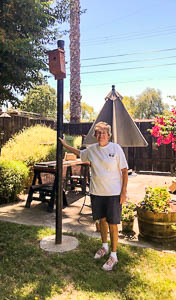

- Placing your nest box under an eave could be beneficial. Place it on the side of the house facing an open area away from prevailing winds and midday sun.
- Pretend you are a nestling and are looking out the entry hole. What do you see? A lawn, a driveway, a garden…if you fledged, where would you land? Would you have a tree to fly to, camouflage to protect you if you landed on the ground? You should take into account what the young fledglings first flight will be like. They will need refuge.
- If you have a nice big tree, a hanging box may work for you.
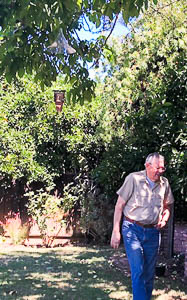
If you are stumped and just cannot decide where to place your backyard nest box, you can always ask us for help. Send us photos of your backyard and details that could factor into a good nest box location. There are never any guarantees that the birds will nest in a box we set up for them! But surely, we can give it a go and have fun trying
